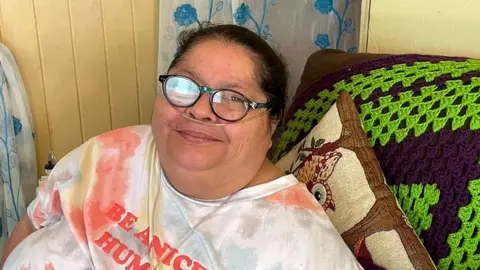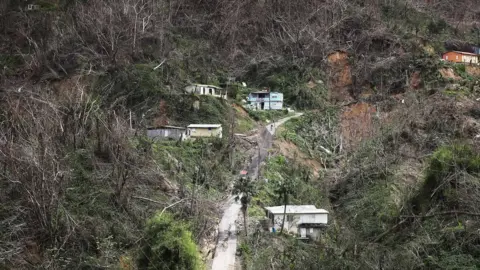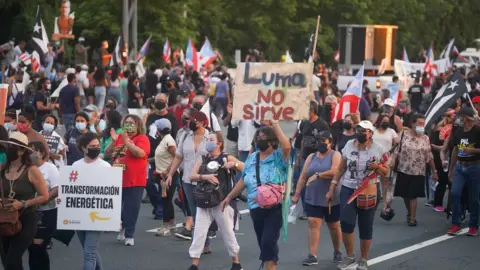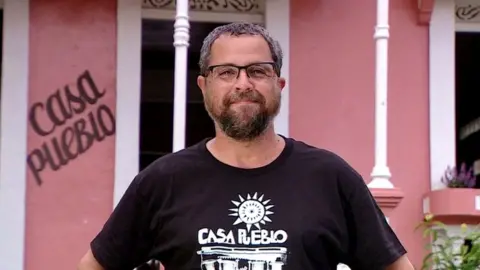Could solar power solve Puerto Rico's energy nightmare?
 BBC
BBCOne small town in the mountains of Puerto Rico is charting a path to a greener, cheaper future - it could be a template for others.
Miguelina Ramos lives in a concrete shack on the hillside in El Hoyo - a near forgotten cluster of just 26 families, far from the stunning Caribbean beaches that make the US territory famous.
To reach her house, visitors must navigate twisty roads, park in a ditch, then push through the overgrowth, past chickens and dozing cats.
Miguelina has lung problems that mean she needs constant access to a ventilator. Until recently, the 57 year old lived in constant fear of power outages.
Outages have become routine in Puerto Rico, since hurricanes swept through the island in 2017.
Back in March, a community organisation installed solar panels on her tin roof. This meant that when a blackout plunged the island's 3.2 million people into darkness last month, Miguelina - unlike nearly everyone else - never lost her light.
 Getty Images
Getty ImagesHer solar system was installed by charity, Casa Pueblo, which has been pushing since the hurricanes to expand rooftop solar across the island, as a cheaper, more reliable power source for everyone.
But the work, funded by donations, is slow-going versus demand, which is soaring as people desperately try to find a solution to rolling blackouts that continue to plague the island's fragile grid.
Miguelina was one of just a dozen families selected from hundreds of applications in the most recent round of work.

'We could be a model'
Installing a solar system, with back-up batteries, can cost tens of thousands of dollars in Puerto Rico - a prohibitive sum for most people on the island, where the median income is $21,000 (£16,100).
But after two hurricanes and then a major earthquake, left the island's power grid in tatters, the US government's disaster agency set aside a huge support package of roughly $10 billion (£8.1bn) - an unprecedented amount.
Activists on the island say this is a golden opportunity to dramatically expand rooftop solar power, while transforming a dysfunctional system into a prototype for grids of the future.
"I see a lot of applicability for this elsewhere [in other US states], if we could get this done here," says environmental lawyer, Ruth Santiago, who is also on the White House Environmental Justice Advisory Council. "We could definitely be a model of rapid transformation of an electric grid,"
But the island - which gets just 3% of its electricity from renewable sources currently - is a reminder that even with money in hand, using it to achieve a future less dependent on fossil fuels is no sure thing.
Since the funds were released nearly two years ago, almost nothing has been spent.
Despite widespread consensus on the need to adopt more renewable energy sources - and a law mandating transition - advocates say the plans for rebuilding prioritise reducing reliance on coal by boosting natural gas imports, rather than embracing renewables as a cheaper, more reliable alternative.
"From an environmental, financial, fiscal, economic point of view - probably even a legal point of view, they should be investing in renewable energy as the predominant resource. And they're not," says Tom Sanzillo, director of financial analysis at the Institute for Energy Economics and Financial Analysis.
It's an infuriating situation for Puerto Ricans. "That they fix the system they have, that really doesn't help us," adds Miguelina. "Putting solar panels [in] for everyone is much better."

Strategy for the future
LUMA Energy, is the private company that took over management of much of Puerto Rico's power system last year. It does not run power plants but handles transmission, distribution and customer complaints among other things.
Since June, it has hooked-up more than 18,000 rooftop solar systems for households plus created a map to make it easier for renewable energy companies to connect to the grid.
Yet the firm's boss, Wayne Stensby, says the island can't simply shift to solar without making the system it already has more reliable, which means investments in the traditional grid.
"That idea of a more decentralised grid, with more renewable energy, is part of the future here, for sure," he says. "That doesn't get away from needing a solid, robust electric system, so that you are able to reliably transmit energy across Puerto Rico and effectively integrate those resources."
Mr Stensby started work in 2020 after the previous utility company, PREPA, declared bankruptcy. Much of his work has been crisis management: resolving outages; routing staff past blockades created by the old utility's trade union; ensuring equipment isn't left to rot in warehouses without roofs.
But there is little patience for this among the public, especially as utility bills - already some of the highest in the US - creep ever higher.
"Every day it rises. It's an incredible assault on the people," says Jose Anibal Gonzalez, a 78-year-old former teacher, who lost power for days in the recent blackout. "They're bleeding us dry."
 Getty Images
Getty Images'Blame game'
"I think there's a blame game [over] who's responsible," says Jenniffer Gonzalez-Colon, who represents the US territory in Washington D.C. "From my perspective, nothing has been happening and that's something that makes you angry, when you actually made Congress approve a lot of funds for the island."
While she primarily faults LUMA and PREPA for inaction- neither company submitted any substantive spending proposals to the government until March - her views on rebuilding the grid resemble Stensby's.
Ms Gonzalez-Colon supports renewables, but says the island - especially its manufacturing sector - urgently needs reliable electricity right now.
"We need to take into account that 45% of our economy is pharmaceuticals, medical device manufacturing that requires reliable stable power 24-7, in peak as well as off-peak," she says. "That means you cannot use batteries only. You need to have a mix".

In the meantime, people on the island are taking matters into their own hands.
"The transformation, what we call it, an energy insurrection, a bottom-up approach to transform our energy landscape is happening." says Casa Pueblo's Arturo Massol-Deya.
Down the road from Miguelina in Adjuntas, where the organisation is based, solar panels now light town lampposts and top the roofs of hundreds of homes.
The group's most ambitious project yet - a microgrid connecting 20 businesses and a church around the main square - is set for completion this summer.
Mr Massol-Deya says when Casa Pueblo installed the first solar panels in 1999, they were received as little more than a curiosity. But the hurricanes were a turning point.
Now it's just a question of whether the rest of the island will follow.
